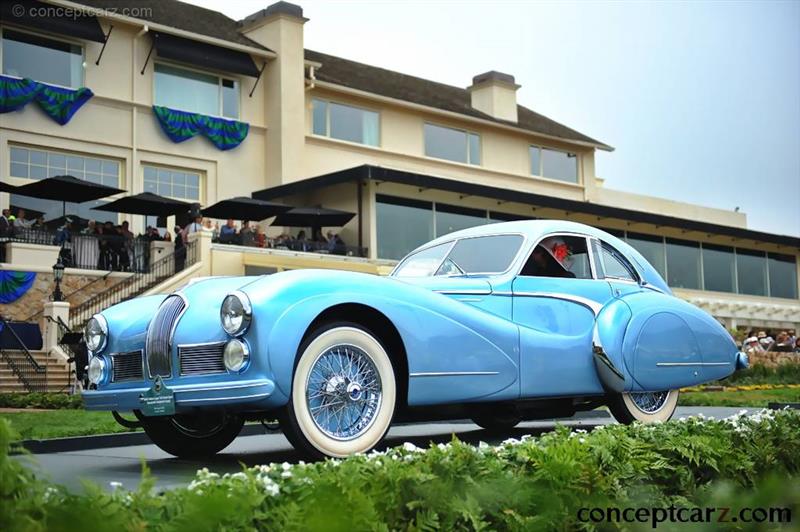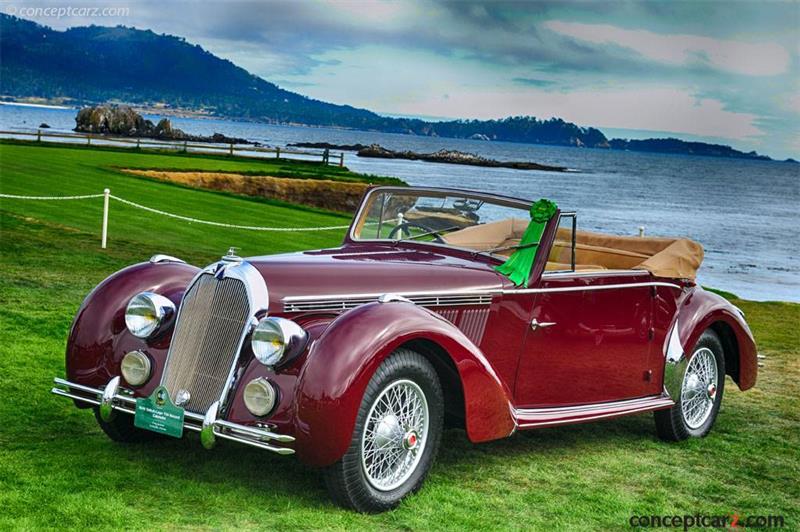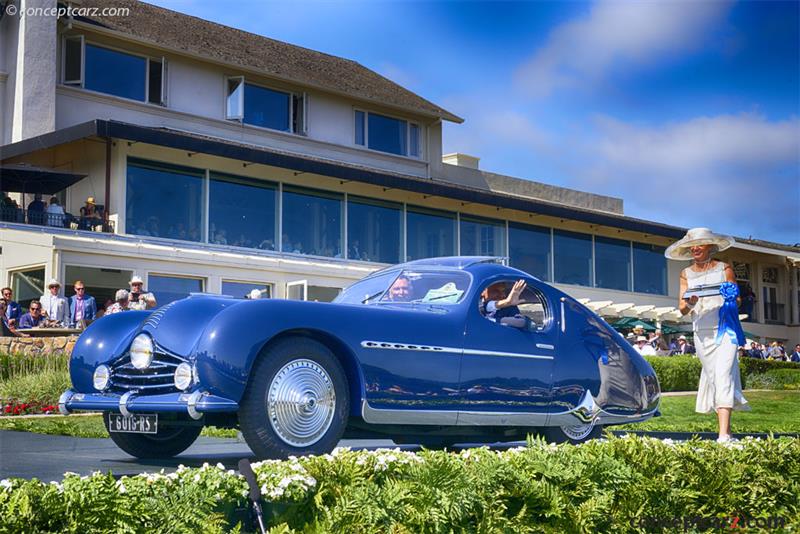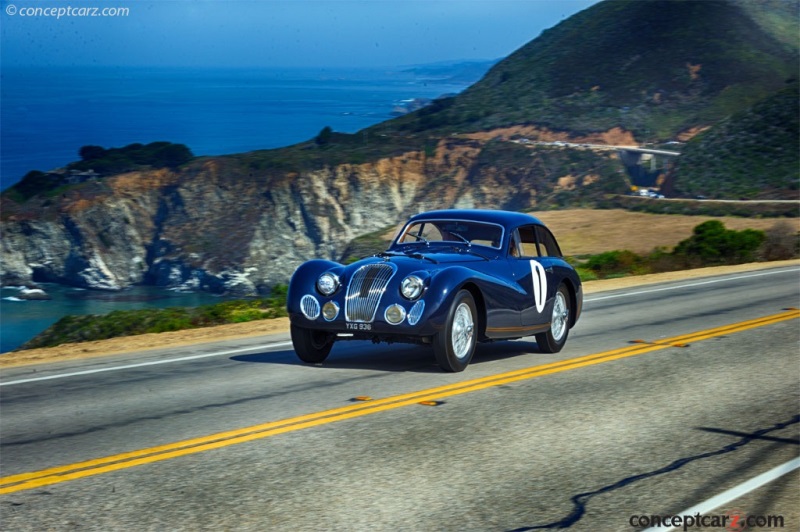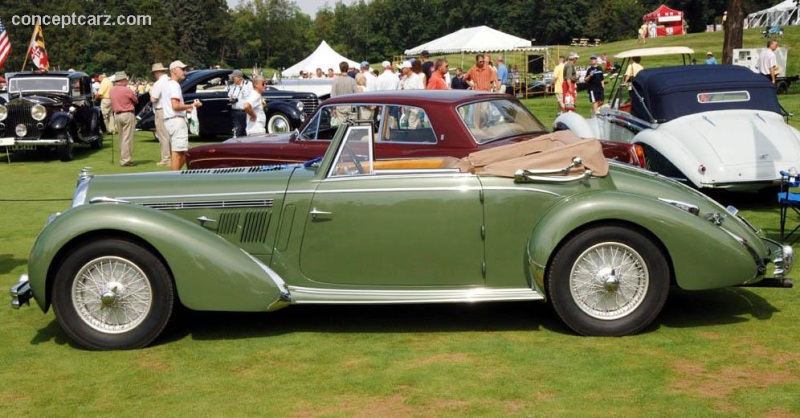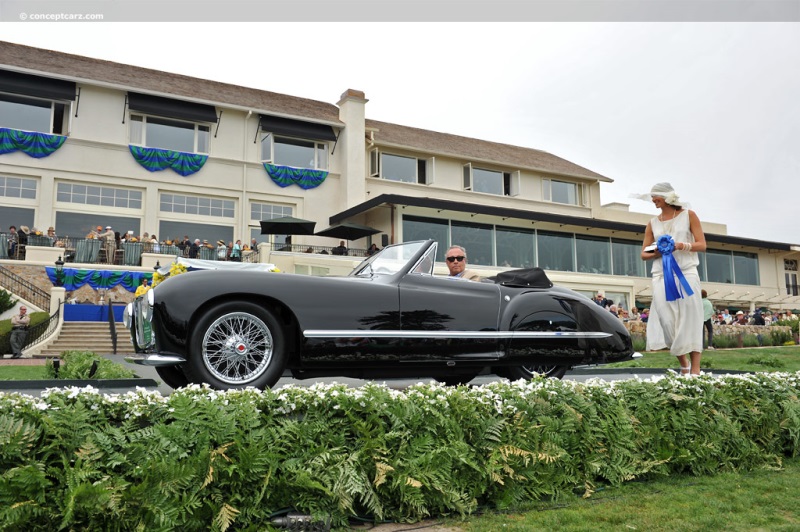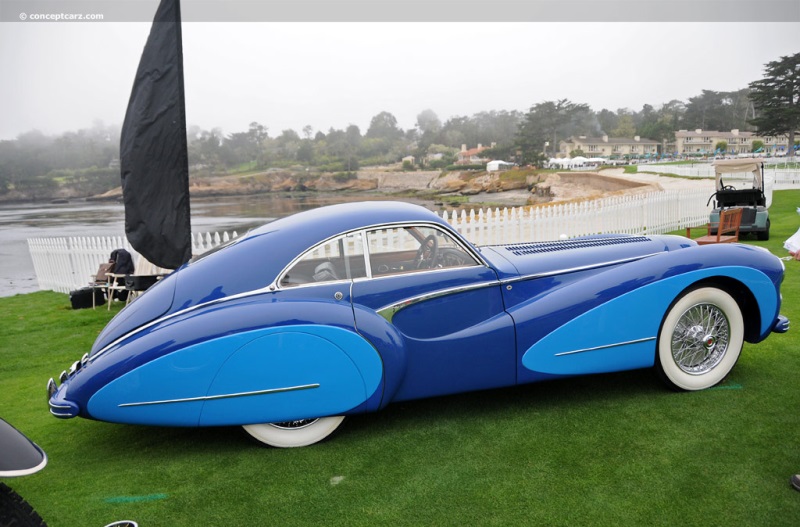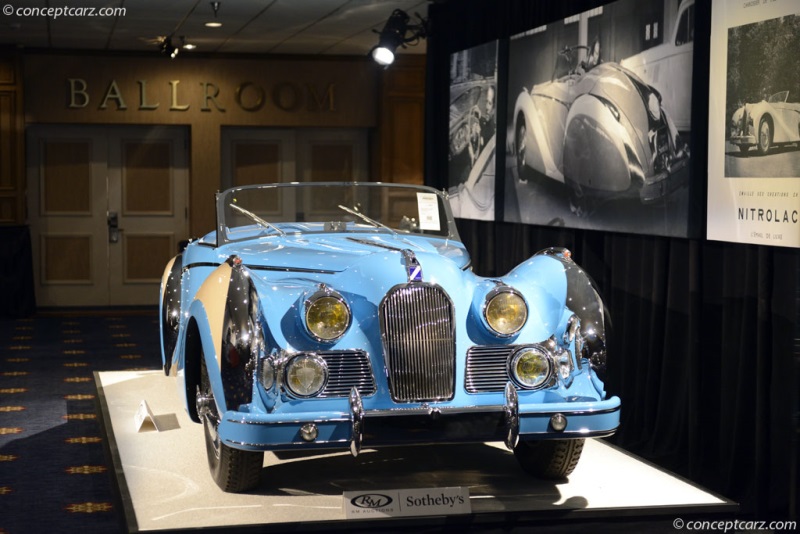Tony Lago became general manager of Automobiles Talbot in 1934, arriving with orders from Talbot's parent company, Sunbeam, in Britain, to revive the ailing company. What Tony found was a solid company with an uninspired product and an unmotivated staff. Tony recognized the potential, used his skills and experience to re-energize the company, and went so far as to acquire it in 1935. He continued to produce the existing line, although now called Talbot Lagos, and immediately set about creating a new higher-performance engine by adapting an overhead valve head with hemispherical combustion chambers, creating the Grand Sport model. It proved highly successful and, along with a companion chassis-only-model for coachbuilders called the 'Lago SS', was largely responsible for the marque's survival.
By 1938, Talbot-Lago introduced the 4.0-liter 'Monoplace' Grand Prix car, powered by the inline six-cylinder engine with a camshaft placed high in the cylinder block now cast from light alloy. The hemispherical combustion chamber cylinder head, also built from aluminum, had inclined valves operated by pushrods and rocker arms. With three carburetors the Talbot-Lago 'Monoplace' produced approximately 240 horsepower. Although Maserati, Audi, Mercedes-Benz, and Alfa Romeo had finely tuned supercharged models, Talbot-Lago relied on its reliability and fuel consumption, earning it frequent podium finishes and the occasional outright victory.
In October of 1946, following World War II, Talbot-Lago had a small stand behind Peugeot at the Paris Salon. It was there that they introduced the brand-new T26 Record, offering four body styles, including a convertible. It used the trademark pre-selector Wilson-type gearbox, had a fully independent front suspension with transverse leaf spring, and a new 4.5-liter six-cylinder twin-cam Hemi engine that Anthony Lago had developed during the War with Carlo Marchetti, his chief engineer. Lago increased the displacement of the engine to 4.5-liters, and added yet another new Hemispherical combustion chamber head, this time with twin camshafts operating the valve gear and positioned near the top of the new seven main bearing block. The long-stroke (93mm bore by 110mm stroke) six gave Talbot-Lago's new grand Prix racer, designated the Type 26 Course or T26C, the necessary torque to carry the slightly heavy (about 100kg more than any of its competition) car. The substantial channel frame was responsible for much of the weight, based on components engineered for use in Talbot-Lago's production road cars. They were, however, immensely powerful machines which often enjoyed a much better fuel economy than the competition. The combined strategy of precise sports car handling, durability, fuel economy, and power continued to earn the company class and overall victories. Louis Rosier won the 1948 Coupe du Salon while finishing second at Monte Carlo, Comminges and Albi. In 1949 Louis Chiron captured the French GP in a T26C, and Raymond Sommer was a winner at the Coupe du Salon. Philippe Etancelin scored the victory in the Paris GP and Rosier earned a victory at the 1949 Belgian Grand Prix.
Talbot-Lago, unlike Delahaye, maintained its own in-house coachbuilding facility, thus the vast majority of the chassis were fitted with open or closed factory body styles. The T26 Grand Sport (GS) was the exception and was delivered solely as a bare chassis requiring bespoke coachwork. Many were clothed by Franay, Oblin, Figoni et Falschi, and Saoutchik. The Grand Sports were similar to the Grand Prix cars but longer and wider and available in either a 104- or 110-inch wheelbase length.
The GP-derived Grand Sport, resting on a shortened wheelbase of 2,650 millimeters, used an independent front suspension by transverse leaf and was a direct descent of the pre-war T150-C SS model. It was virtually identical to its T150 predecessor, except for the more powerful 4.5-liter T26 engine with three carburetors and an aluminum cylinder head. It developed 190 horsepower due to hotter cams, lighter pistons, and higher compression. The T26 Grand Sport was the culmination of the great tradition of the truly custom motor car, equally adaptable for the serious sportsman or the chic Parisian society, and designed to carry the most elegant, sporty, and/or luxurious coachwork.
The price tag was stratospheric and its practicality was limited, making it nearly irrelevant. It was exclusive, rare, and outrageous, with just 29 examples built on the short wheelbase, all with individual coach-built bodies.
This new, high-performance engine was reliable and smooth and ideal for luxurious grand touring models, which were fitted with hydraulic brakes, 18-inch Rudge wire wheels, shock absorbers, and an independent front suspension. These Grand Touring luxury road cars were designed for the elite motoring enthusiasts of Europe, where style, speed, and comfort were equally important.
by Daniel Vaughan | Sep 2020
By 1938, Talbot-Lago introduced the 4.0-liter 'Monoplace' Grand Prix car, powered by the inline six-cylinder engine with a camshaft placed high in the cylinder block now cast from light alloy. The hemispherical combustion chamber cylinder head, also built from aluminum, had inclined valves operated by pushrods and rocker arms. With three carburetors the Talbot-Lago 'Monoplace' produced approximately 240 horsepower. Although Maserati, Audi, Mercedes-Benz, and Alfa Romeo had finely tuned supercharged models, Talbot-Lago relied on its reliability and fuel consumption, earning it frequent podium finishes and the occasional outright victory.
In October of 1946, following World War II, Talbot-Lago had a small stand behind Peugeot at the Paris Salon. It was there that they introduced the brand-new T26 Record, offering four body styles, including a convertible. It used the trademark pre-selector Wilson-type gearbox, had a fully independent front suspension with transverse leaf spring, and a new 4.5-liter six-cylinder twin-cam Hemi engine that Anthony Lago had developed during the War with Carlo Marchetti, his chief engineer. Lago increased the displacement of the engine to 4.5-liters, and added yet another new Hemispherical combustion chamber head, this time with twin camshafts operating the valve gear and positioned near the top of the new seven main bearing block. The long-stroke (93mm bore by 110mm stroke) six gave Talbot-Lago's new grand Prix racer, designated the Type 26 Course or T26C, the necessary torque to carry the slightly heavy (about 100kg more than any of its competition) car. The substantial channel frame was responsible for much of the weight, based on components engineered for use in Talbot-Lago's production road cars. They were, however, immensely powerful machines which often enjoyed a much better fuel economy than the competition. The combined strategy of precise sports car handling, durability, fuel economy, and power continued to earn the company class and overall victories. Louis Rosier won the 1948 Coupe du Salon while finishing second at Monte Carlo, Comminges and Albi. In 1949 Louis Chiron captured the French GP in a T26C, and Raymond Sommer was a winner at the Coupe du Salon. Philippe Etancelin scored the victory in the Paris GP and Rosier earned a victory at the 1949 Belgian Grand Prix.
Talbot-Lago, unlike Delahaye, maintained its own in-house coachbuilding facility, thus the vast majority of the chassis were fitted with open or closed factory body styles. The T26 Grand Sport (GS) was the exception and was delivered solely as a bare chassis requiring bespoke coachwork. Many were clothed by Franay, Oblin, Figoni et Falschi, and Saoutchik. The Grand Sports were similar to the Grand Prix cars but longer and wider and available in either a 104- or 110-inch wheelbase length.
The GP-derived Grand Sport, resting on a shortened wheelbase of 2,650 millimeters, used an independent front suspension by transverse leaf and was a direct descent of the pre-war T150-C SS model. It was virtually identical to its T150 predecessor, except for the more powerful 4.5-liter T26 engine with three carburetors and an aluminum cylinder head. It developed 190 horsepower due to hotter cams, lighter pistons, and higher compression. The T26 Grand Sport was the culmination of the great tradition of the truly custom motor car, equally adaptable for the serious sportsman or the chic Parisian society, and designed to carry the most elegant, sporty, and/or luxurious coachwork.
The price tag was stratospheric and its practicality was limited, making it nearly irrelevant. It was exclusive, rare, and outrageous, with just 29 examples built on the short wheelbase, all with individual coach-built bodies.
This new, high-performance engine was reliable and smooth and ideal for luxurious grand touring models, which were fitted with hydraulic brakes, 18-inch Rudge wire wheels, shock absorbers, and an independent front suspension. These Grand Touring luxury road cars were designed for the elite motoring enthusiasts of Europe, where style, speed, and comfort were equally important.
by Daniel Vaughan | Sep 2020
Related Reading : Talbot-Lago T-26 History
Anthony Lago had taken over control of the Talbot factory in Suresnes after the merger with Sunbeam and Darracq had collapsed in 1936. By 1937 he had introduced a new line of vehicles, two of which were entered in the grueling 24 Hours of Le Mans. He continued his racing endeavors by moving to single-seat racers, and by 1939, a purpose-built Grand Prix car had been completed. The onset of World War....
Continue Reading >>
Continue Reading >>
1948 Talbot-Lago T-26 Vehicle Profiles
Recent Vehicle Additions
Performance and Specification Comparison
T-26 Specification Comparison by Year
Year
Production
Wheelbase
Engine
Prices
103.00 in., 123.00 in., 125.00 in.
6 cyl., 273.51 CID., 170.00hp
6 cyl., 273.51 CID., 195.00hp
6 cyl., 273.51 CID., 195.00hp
Related Automotive News

1932 Duesenberg J Figoni Sports Torpedo Named Best of Show at the 71st Pebble Beach Concours d'Elegance
2022 Charitable Donations Surpass %242.67 Million
A unique Duesenberg reprised its early role as Concours winner by taking the top prize at the Pebble Beach Concours dElegance.
This year, 40 classic cars from 18 countries and 33 states pulled...

Mullin Automotive Museum to Showcase Six French Classics During Monterey Car Week
The Mullin Automotive Museum announces today it will display six exquisite vehicles at various events during Monterey Car Week on August 17-21, 2022. Guests of the Rolex Monterey Motorsports Reunion, The Quail, A Motorsports Gathering and the Pebble...

2019 Pebble Beach Concours d'Elegance Best of Show Winner
1931 Bentley 8 Litre Named Best of Show at the 69th Pebble Beach Concours dElegance
PEBBLE BEACH, Calif. (August 18, 2019) — Every August, the history of the automobile rolls onto the competition field of the Pebble Beach Concours dElegance...

Exhibit At The Mullin Automotive Museum Presents The Rarest And Most Beautiful Cars From Preeminent French Coachbuilders
Titled Lépoque des Carrossiers The Art and Times of the French Coachbuilders, the exhibit will open on April 14, 2018 and showcase striking examples of hand-built coachwork on some of the most revered and acclaimed cars in the world, including...

2015 Pebble Beach Concours d'Elegance Best of Show
PEBBLE BEACH, Calif. (August 17, 2015) -- An Italian Isotta Fraschini Tipo 8A Cabriolet that once turned heads and garnered top prizes in the classic era glided to victory at the 65th Pebble Beach Concours dElegance on Sunday.
The competition...





























